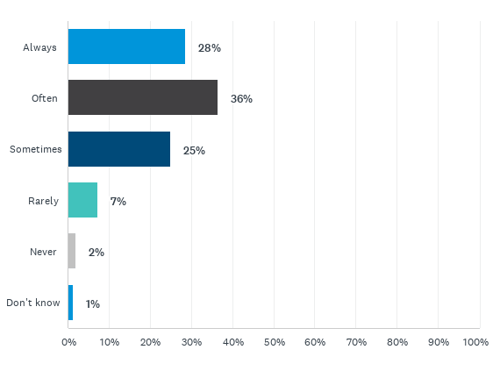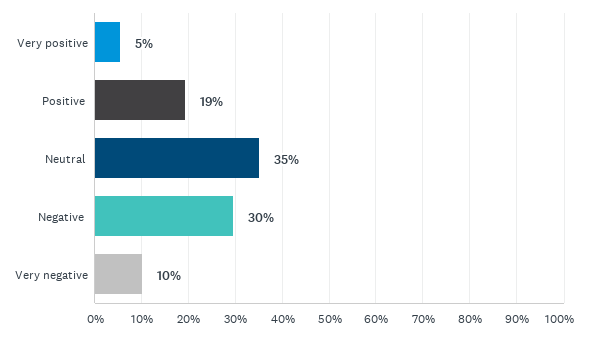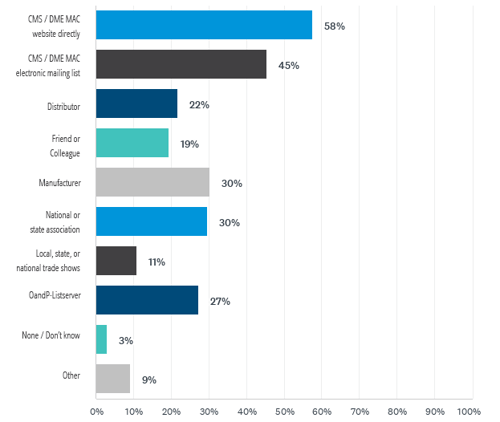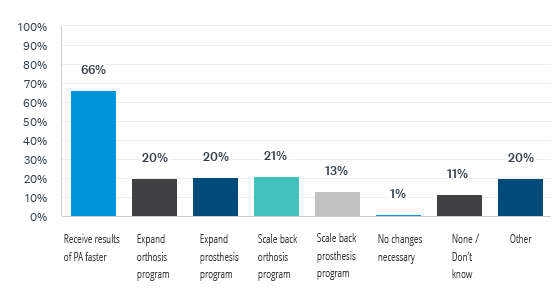
Prior authorization (PA) helps Durable Medical Equipment, Prosthetics, Orthotics, and Supplies (DMEPOS) suppliers ensure that Medicare coverage, payment, and coding rules are met before DMEPOS items are delivered. The Centers for Medicare & Medicaid Services (CMS) issued a final rule on December 30, 2015, that would establish prior authorization for DMEPOS items. The ruling was made to safeguard Medicare patients against having to pay the costs for items not eligible for Medicare coverage. PA was initially rolled out for Power Mobility Devices in 2016. It would not be until 2020 before lower limb prosthetic devices joined the program.
On January 12, 2022, CMS announced in the Federal Register updates to the Master List and the selection of certain lower limb orthoses, lumbar sacral orthoses, and power mobility devices. Effective April 13, 2022, the devices are subject to required prior authorization. See the Policy Groups section for more information.
See the full list of codes on the Required Prior Authorization List.
See the full list of codes on the Master List.
Because PA is relatively new to the O&P industry, we wanted to understand the attitudes and experiences of O&P professionals who are grappling with the policies. We ran a survey with the aim of learning how professionals felt about the new policy changes and collect feedback about how the program was communicated.
We’re eager to share the results of the survey and thankful to everyone who responded. If you would like to know when we launch the next SPS Trends Survey, click here to join our email list.
Methodology
The online survey was published on May 2022 and closed in June 2022. We asked questions designed to gauge O&P professionals’ overall sentiment about CMS’ prior authorization and PDAC policy changes and collect feedback on how the program was communicated.
The survey was not restricted to only SPS customers, answers from anyone within the O&P industry were welcomed. We shared the survey to our social media channels, email, SPS online store, and the OANDP-L Listserver. Most responses came from individuals who worked at O&P facilities.
The percentages shared in this article are part of a total of 165 responses we received over that month. Questions in the survey include:
In your experience, how often does prior authorization delay access to care for patients?
How has the PDAC verification process changed your decision-making process when selecting a device for a patient?
What is your perception of prior authorization on overall clinical outcomes?
Where do you get your information concerning CMS policy changes, such as prior authorization and/or PDAC verification?
Have you read specific Local Coverage Determinations (LCDs)?
What changes would you like implemented in the prior authorization process?
Summary
Responses to this survey were mixed. This may reflect the different levels of familiarity with the Prior Authorization process. For instance, a prosthetist would have had more experience than orthotists in submitting PARs because the prosthetics program was implemented sooner.
An example of this divide comes from the question: What changes would you like implemented in the prior authorization process? Answers were split between wanting the orthosis program scaled back (21%), wanting the orthosis program expanded (20%), and wanting the prosthesis program expanded (20%). Only 13% selected the option to scale back the prosthesis program, possibly because prosthetists have become more accustomed to the process.
Prior authorization and PDAC are impacting the O&P industry in new and sometimes challenging ways. It’s clear that clinicians are feeling burdened by some aspects of the policies, such as selecting a PDAC-verified device (44%) and waiting on PA results (67%). Other responses from the survey suggested that the impact to patient outcomes was neutral (34%) or it improved outcomes (19%). Overall, responses were very mixed.
It will be interesting to see how these sentiments evolve year over year. Until then, we have included helpful resources in this article and ways you can help improve CMS policies.
The following includes the results from the 2022 SPS Trends Survey.
“In your experience, how often does prior authorization delay access to care for patients?”
Concerns about delaying access to care was top of mind when CMS initially announced prior authorization was coming to six lower limb codes. Now that we are two years into the change, the concern is still very much at the forefront of clinicians’ minds. In this survey, respondents indicated that prior authorization delays access to care Always (28%) or Often (37%). 34% of respondents noted prior authorization Sometimes (25%), Rarely (7%), or Never (2%) delayed access to care.
"In your experience, how often does prior authorization
delay access to care for patients?"

According to the DMEPOS Operational Guide last updated April 12, 2022, initial submission of a prior authorization request (PAR) will be reviewed and sent within 10 business days of receipt. For lower limb prosthesis patients, the evaluation and casting process can be started within those 10 days, but delays may arise if the PAR needs to be resubmitted. The primary culprit for denied PARs is incomplete or incorrect information submitted. CGS and Noridian offers live and recorded webinars to help you familiarize with documentation best practices.
The quickest way to manage the submission and resubmission process is via the online portal for your jurisdiction:
- If you operate in Jurisdiction A or D, register for Noridian Medicare Portal (NMP)
- If you operate in Jurisdiction B and C, register for DME myCGS portal.
But what about orthotic devices that require immediate delivery to stabilize a patient? When CMS added five orthosis codes to the list of codes that require Medicare prior authorization in January 2022, the American Orthotic and Prosthetic Association heard feedback from members concerning the challenges this requirement posed to patients needing immediate orthosis support. In April 2022, CMS revised the requirement to suspend the two-day expedited review process for cases that would delay care and risk the health or life of the beneficiary.
The new orthosis additions to prior authorization are currently being implemented in a phased approach, and will be fully implemented October 10, 2022. National associations are working closely with CMS and the DME MACs to communicate member feedback and facilitate a smooth transition. If you have feedback about the policy changes, connect with your state or national associations so they can champion needed policy changes.
“How has the PDAC verification process changed your decision-making process when selecting a device for a patient?”
PDAC refers to the Pricing, Data Analysis and Coding contractor that maintains the Durable Medical Equipment Coding System (DMECS). DMECS is the source for DMEPOS product code verification and assignment. When a product is ‘PDAC verified,’ it means the code has been reviewed and assigned a code by PDAC for the purpose of billing Medicare.
As of this writing, PDAC verification is only required for six lower limb prosthesis codes and is being implemented in a phased approach for five orthosis codes. 44% of those surveyed marked that it limited their options for selecting a device for a patient. It’s unclear if this response is a positive or negative side-effect to PDAC. It may be positive because when options are reigned in, decisions can be made faster and more confidently. Alternately, their desired device may not be included in the limited list of options. In future surveys we hope to dig into this question more.
"How has the PDAC verification process changed your
decision-making process when selecting a device for a patient?"
-1.png?width=600&name=Chart_Q4_220726%20(2)-1.png)
34% indicated that PDAC did not affect their decision-making process (22%), PDAC expanded their options (6%), or it made it easier to select a device (7%). Overall, opinions were divided for this question.
If you are struggling to select a device, you can leverage the buttons located on the SPS Online Store homepage to navigate to PDAC-approved devices. PDAC-approved items are listed with a blue ribbon.

“What is your perception of prior authorization on overall clinical outcomes?”
Responses were also closely divided on this question. Neutral was the highest selected option at 35%, followed by Negative at 30%, and finally Positive was reported by 19%. The lack of consensus may be because clinicians are going to do whatever is right for their patients regardless of policy. Another possibility is that the scenarios where prior authorization impeded clinical outcomes were minor and few.
"What is your perception of prior authorization
on overall clinical outcomes?"

“Where do you get your information concerning CMS policy changes, such as prior authorization and/or PDAC verification?”
Prior Authorization and PDAC information is being disseminated through many channels, but most of respondents receive information from CMS directly with 58% sourcing information from their website and 45% from the electronic mailing list. Other channels leveraged include Manufacturer (30%), National or State Associations (30%), and the OandP-Listserver (27%).
"Where do you get your information concerning CMS policy changes,
such as prior authorization and/or PDAC verification?"

CMS must communicate policy changes 60 days prior to the changes taking place. Stay informed by signing up for CMS’ electronic mailing list.
”Have you read specific Local Coverage Determinations (LCDs)"
The Medicare Administrative Contractor (MAC) issues Local Coverage Determinations (LCDs) to define whether a particular item or service is covered in the MAC’s jurisdiction in accordance with section 1862(a)(1)(A) of the Social Security Act. 86% of survey respondents indicated they had read an LCD.
Click here to explore Local Coverage Determinations.
"Have you read specific Local Coverage Determinations (LCDs)?"

“What changes would you like implemented in the prior authorization process?”
67% of respondents reported they wanted to receive results of prior authorization faster. An interesting finding of the survey was that respondents were equally split between wanting the orthosis program scaled back (21%), wanting the orthosis program expanded (20%), and wanting the prosthesis program expanded (20%). Only 13% selected the option to scale back the prosthesis program. This may be because the prosthesis program has been around since 2020, while the orthosis program is relatively new.
"What changes would you like implemented
in the prior authorization process?"

Conclusion
Prior Authorization and PDAC have created a different ball game for clinicians. As new codes are being added to prior authorization and documentation is needed earlier in the process, it’s clear the changes are challenging for many clinicians and administrators. Alternately, we collected many positive responses that view the change as potentially improving patient outcomes. Overall, more research is needed to understand the full impact on clinicians. We hope to issue this survey again next year. Click here to join our email list to be notified when new surveys launch.
The best way to get ahead of the policy changes and equip yourself with information is to sign up for CMS’ e-newsletter, workshops, and webinars. Another invaluable tool is to get involved with your state or national association. Help close the feedback loop by talking to your state association or National Association about any concerns you may have so they can advocate for policy improvements.
Thank you to everyone who responded. We hope to launch another survey again soon. In the meantime, what do you think of these stats? Leave a comment below!
Interested in participating in our next survey? Join our email list.
See also:
SPS Trends Survey 2022: Snapshot of Inventory Management in O&P



